6 charts that show why all schools won’t be in trusts by 2030

The plan for a fully academised school system has been touted by the government for some time - most notably in its Schools White Paper, published last year, which set the target for this to be achieved by 2030.
However, hitting that goal now seems highly unlikely, and striving for it would risk schools moving at such a rate that the quality of academy trusts could not be guaranteed, according to a paper from the National Foundation for Educational Research published this week.
“The suggested pace and timing of system change risks creating issues for trust quality, potentially affecting the educational outcomes for young people,” said Jenna Julius, NFER research director and co-author of the report.
For its report, the NFER collated recent Department for Education data on the school sector to illustrate the huge variation in multi-academy trusts (MATs), single-academy trusts (SATs) and local authority (LA) maintained schools; the mix of academy trust sizes; and, notably, the regional variations that underscore why a fully academised system by 2030 seems unlikely.
The truth about multi-academy trust growth
1. The primary/secondary split
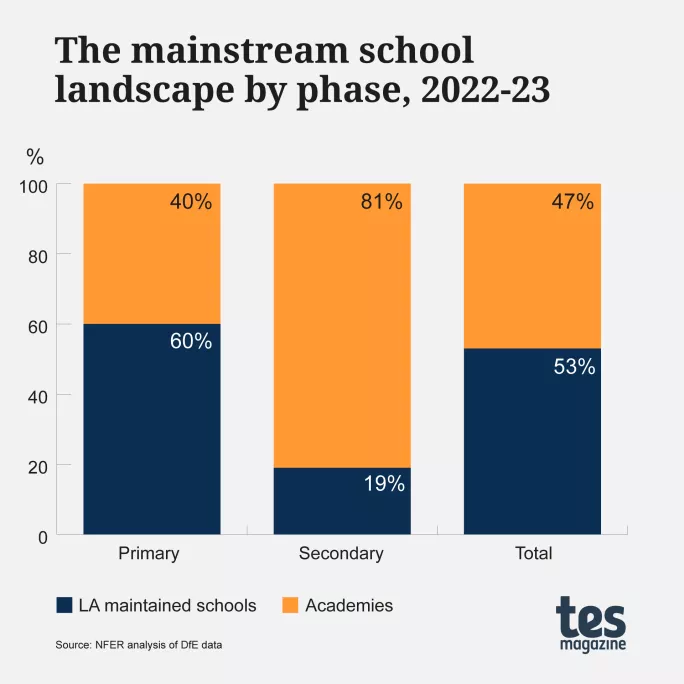
As the image above makes clear, there is a disparity between the proportions of primary and secondary schools that have joined academy trusts, with primary schools clearly less convinced about making the move.
Given that there are many more primary schools than secondary schools, this means that despite over 80 per cent of secondaries now being academies, the overall market share for academies versus LA schools is roughly equal.
Clearly, then, if the government - this or the next - wants to hit an ambitious target for academisation, it will need to focus on convincing primary schools to join MATs.
2. Size of trusts
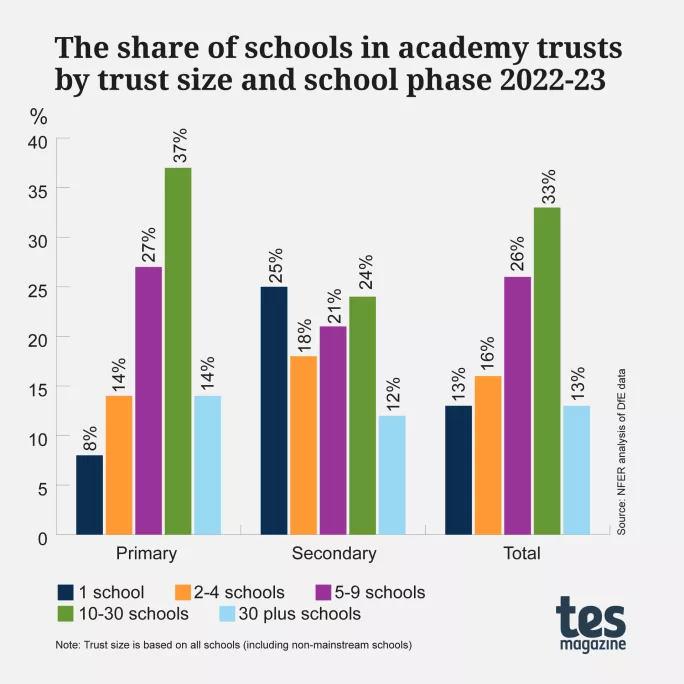
One of the government’s big aims for its academies push has been that schools join “strong trusts”.
What this means has only ever been vaguely defined, with the most common definition revolving around a figure of either 7,000 pupils or 10 schools, as this is believed to be where benefits of scale kick in.
The table above shows that trusts of between 10 and 30 schools have the largest market share. However, this finding comes with the caveat that primary schools are more often found in trusts of this size than secondaries.
Indeed, for secondary schools alone, single-academy trusts have the largest market share. The government will have to do work here to convince those that want to go it alone that they would be better off in someone else’s trust.
3. The rise of bigger MATs
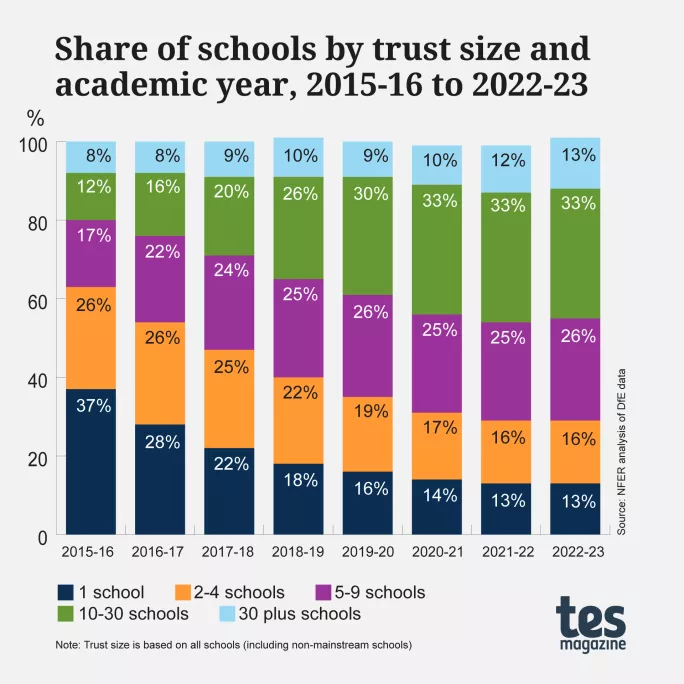
Another interesting data set in the NFER report details the change in the size of trusts over the past eight years, with clear growth in larger MATs of 10 to 30 schools at the expense of smaller ones.
Very large trusts of over 30 schools have grown, too, although it seems that the preference for these super trusts that emerged in the early part of the past decade has eased off in favour of the more medium-sized trusts.
The decline of single-school trusts shown above illustrates again how primary schools influence the dataset as, despite the clear drop-off over the past seven years, these remain the most popular form of trust set-up for secondary schools.
More must-read articles on multi-academy trusts
4. Slowing growth of MATs
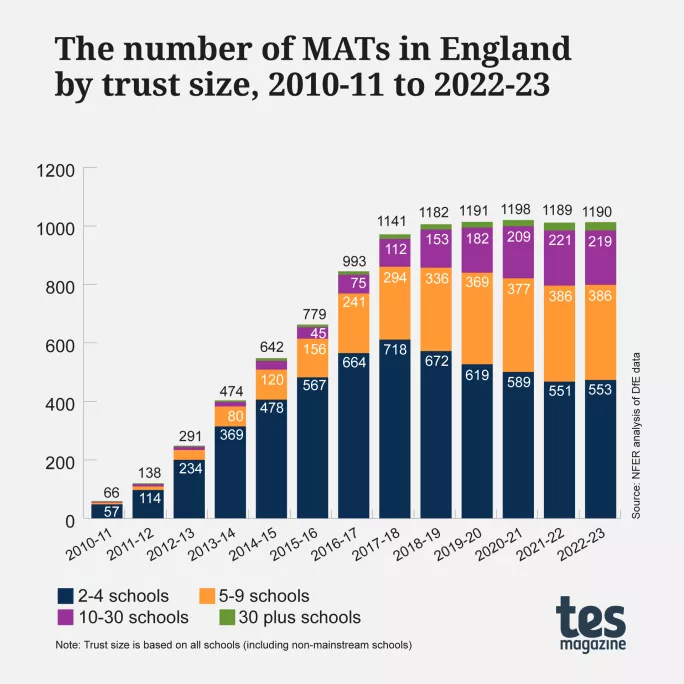
Despite the changing trends in trust size, the actual number of MATs has plateaued over the past five years, rising by just 49 in that time.
The pandemic clearly had an impact on MAT expansion, with the number declining by nine between 2020-21 and 2021-22. The graph above does not include single-academy trusts, but as the graph in the previous section shows, the number of SATs has been declining.
For the government, it suggests that convincing schools to join existing MATs may be a more reasonable plan of action than convincing people to create new MATs. The benefit of existing MATs is that the structures, processes and ways of working are already established.
5. Geographical spread
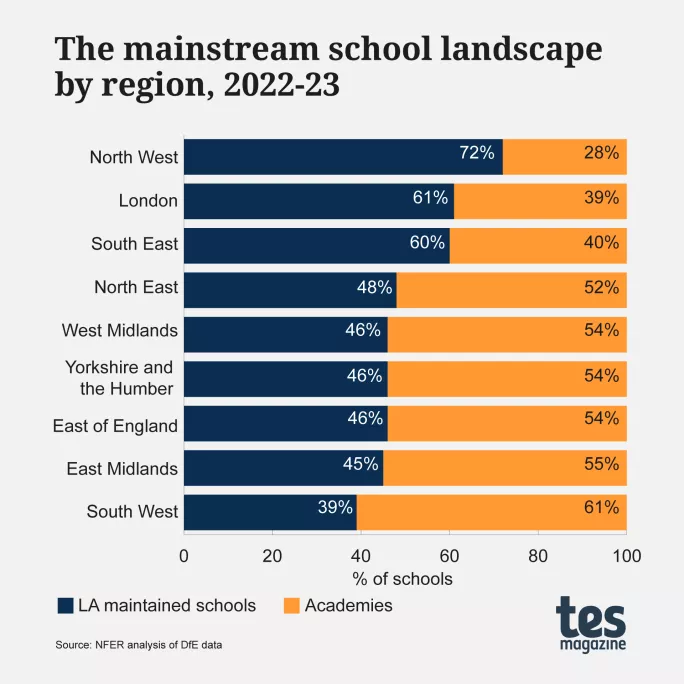
The table above shows the geographical variations in trust growth, with the most academised region - the South West - almost exactly the opposite of London, the second least academised region.
Schools in the North West remain the most resistant to the academisation message, with fewer than one-third making the move.
Perhaps more surprisingly, given their proximity to those in charge, London and the South East are also behind on a shift to academies. However, as these regions have the most schools, it also stands to reason that they may appear further behind but the actual overall number of schools in a trust is higher than in other regions.
The positive for the government, though, is that despite regional variations, the shift to academies is heading in the right direction generally, with six regions now having over half of their schools as academies.
6. The geographical size divide
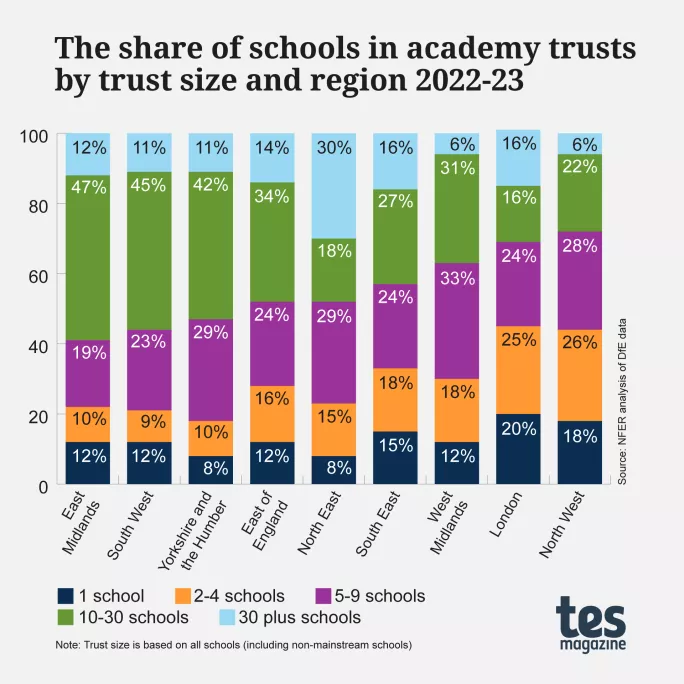
Finally, the graph above shows that within the regional variations in the move to academies, there are also major differences in the size of trusts that have emerged.
Most notable is the North East, where large trusts of 30-plus schools dominate - but in the North West and West Midlands large trusts are few and far between.
In the East Midlands, South West and Yorkshire and the Humber, though, it is trusts of 10 and 30 schools that are most prevalent.
The NFER report says this mix of trust sizes by region makes it clear that a “tailored regional approach” is needed if an all-MAT system is to be created. No doubt the government’s regional directors will be mindful of their work in this area.
All images used with permission from the National Foundation for Educational Research
Register with Tes and you can read two free articles every month plus you'll have access to our range of award-winning newsletters.
Keep reading with our special offer!
You’ve reached your limit of free articles this month.
- Unlimited access to all Tes magazine content
- Save your favourite articles and gift them to your colleagues
- Exclusive subscriber-only stories
- Over 200,000 archived articles
- Unlimited access to all Tes magazine content
- Save your favourite articles and gift them to your colleagues
- Exclusive subscriber-only stories
- Over 200,000 archived articles
topics in this article



